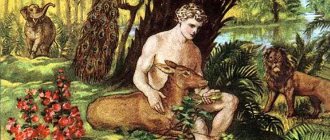So what did scientists discover?
The American popular science magazine Cell published an article: a group of American and Israeli biologists analyzed DNA fragments from parchment that served as material for the “Dead Sea Scrolls.” And I found out that many of these scrolls were written on cow skin. This means that they were clearly not made in Qumran (an area on the northwestern shore of the Dead Sea), where they were first discovered, and not in the vicinity of the Dead Sea at all: after all, cows were never kept in these desert places, there are no pastures there. This means that the Dead Sea Scrolls have a different origin - they were probably brought to Qumran from the fertile regions of Palestine, and perhaps from even more distant territories, the authors of the article write.
Qumran National Park
Ferdinand code
Ferdinand code
To protect military information from his enemies, King Ferdinand of Spain wrote it down in a secret code. As a result, his cipher proved too effective, and the king's correspondence with a commander named Gonzalo de Cordoba remained undeciphered for 500 years. Ferdinand sponsored Christopher Columbus's expeditions to the Americas and fought several enemies. He conquered Spain from the Moors in 1492 and fought France over the Mediterranean. Since the letters could contain invaluable information about Ferdinand's military campaigns, Spanish intelligence services were involved in the decryption. Ferdinand's alphabet consisted of 88 symbols, 237 letters and six accompanying symbols (such as numbers and triangles), making the meaning of each letter more complex. In addition, the text of the “language” was continuous, and the words were not separated by spaces. In 2021, six months later, the agency was able to decipher enough code to read four pieces of correspondence. Many details became known, from instructions for the deployment of troops in Italy and ending with the scolding of the commander for making decisions without Ferdinand's approval.
Can you tell us more about how they were found?
In 1947, Bedouin shepherds were wandering through the Qumran desert, looking for a runaway goat, and discovered an inconspicuous cave, and in it - clay jugs. They did not contain gold, as they had hoped, but half-decayed leather scrolls with ancient inscriptions, wrapped in linen. Later they found another cave, there were more jars with scrolls. Then the third, fourth...
When archaeologists learned about the finds, it turned out that these scraps of ancient parchments were of great value. Using radiocarbon dating, they found that some of the “Qumran scrolls” were created in the middle of the 3rd century BC. Approximately 29% of all manuscripts (and in total about 900 of them were discovered in the vicinity of the Dead Sea) are biblical texts, and they have been preserved fragments of all the books of the Old Testament, with the exception of one and only one - the book of Esther!
Clay jars in which the Qumran scrolls were kept
In the late 1940s - early 1950s. Inspired by the discoveries, archaeologists began to literally comb the surroundings of the Dead Sea and found the remains of ancient manuscripts in other places - for example, in Wadi Murabbaat (west of the Dead Sea), Masada (its southwestern environs), etc. True, religious texts they were not found outside Qumran - only business documents, letters, etc.
Unique Ninja Oaths
Unique Ninja Oaths
In Japan, rumors have been circulating for the last half century about the discovery of written ninja oaths. If this is true, then this would become a priceless “historical diamond.” Unlike ninja movies, real saboteurs usually carried out covert operations to gather intelligence and rarely used weapons. Most of their traditions and teaching habits were passed down orally from master to apprentice. Never before had written documents been found, much less oaths. In 2021, the priceless document finally “resurfaced.” It was donated to the museum by the Kizu family, once a ninja clan from the city of Iga.
The donated treasure consisted of 130 ancient documents, but the oath was the most remarkable. It was written by a man named Inosuke Kizu, who thanked his masters for teaching ninjutsu and vowed never to reveal the secret knowledge even to his close relatives. The 300-year-old documents also stipulated punishment for revealing ninja techniques to outsiders. The author admitted that his betrayal would cause his descendants to be tortured by the gods for generations. The letter was probably given to his masters and returned to Kizu's family after his death.
And why are the Qumran manuscripts so important?
This is a living illustration of how the Jews read and understood the Old Testament Revelation in the pre-Christian era.
For many centuries, the only text in the original language that was widely used among Jews was the Masoretic text (from the Hebrew masora - “tradition”). But this is a very late edition of the books of the Old Testament, made by the Jews already in the 6th-10th centuries after the birth of Christ. Moreover, it was made not least in order to offer an alternative to the Christian interpretation of these texts.
Fragment of the Qumran scroll manuscript
Bestiary of Westminster Abbey (Westminster Abbey Library)
Of all the ancient bestiaries in existence, the Westminster Bestiary is considered one of the most beautiful and richly illustrated. It contains many descriptions of animals, existing and mythological, and also contains legends and myths. The exact author and year of publication are unknown, but the 12th century is indicated.
7
What is the Christian interpretation based on?
First of all, on the understanding that was given by the Lord Jesus Christ Himself and the evangelical apostles, and which is set forth in the four canonical books accepted by the Church as inspired books. – Approx. ed. Gospels. But this understanding in most cases is consistent with the Septuagint - the Greek translation of the Old Testament books (originally written in Hebrew), undertaken in Egypt at the turn of the 3rd and 2nd centuries BC. This correspondence, as well as the fact that the Christian Church chose for sermons in ancient Greek (it was the most widespread in the world at that time), and became the reason for the widespread use of the Septuagint in the Church.
Book of Hours of Jeanne d'Evreux (Metropolitan Museum)
All miniatures in this most valuable manuscript are made in black outlines with dotted lines. There are red outlines, sharpened with shadows and various shiny colors. The Book of Hours was created by Jean Pucelle, who first introduced the grisaille technique to the world.
It's amazing how accurately the smallest details and silhouettes are recorded in this medieval manuscript. The work is now in the New York Metropolitan Museum of Art.
3
But now our trust in these manuscripts has been shaken?
On the contrary, it has increased.
There was one circumstance that forced researchers to treat the Qumran finds with distrust. For a long time it was believed that the Essenes lived on the territory of Qumran - followers of one of the Jewish religious groups, distinguished by their penchant for a harsh solitary life, strict ascetic rules and a number of specific traditions. These traditions did not quite fit into the orthodox beliefs of the Jews; even some pagan elements slipped into them.
An image found on the wall of one of the caves where the Essenes lived
Can the biblical text rewritten by the Essenes be trusted? Didn't they bring something of themselves into it? Moreover, the very first of the discovered “Qumran scrolls” described the customs of the Essenes, and some scientists - for example, the Catholic abbot Roland de Vaux - decided that all other Qumran manuscripts were the result of their work.
Creswell signs
On the border of Nottinghamshire and Derbyshire in England there is a limestone gorge called Craswell Crags, which is of great historical value. As well as being the site of ancient remains in the past, Creswell is also home to the only example of Ice Age art in the UK. After years of exploration, the caves have managed to deliver a big surprise in 2021. The tour group stumbled upon the largest collection of apotropoietic signs in the country.
The engravings on the walls had nothing to do with the images of the Ice Age. The latter were thousands of years older, while the new finds are relatively “fresh” - from medieval times to the 19th century. Historians have recognized several symbols. They were also called witch marks and were intended to protect people from supernatural evil. All the ceilings and walls of the caves were dotted with symbols, which indicates the local residents’ fear of the unknown.
And now it turns out that you were worrying in vain?
Yes, it is now completely clear that this is not so. Most of the manuscripts were only kept in Qumran, but they were created many tens or even hundreds of kilometers away. Perhaps they were part of the library of the Jerusalem Temple - the only place on earth dedicated to the One God, who once revealed himself to Abraham, Moses and the ancient Israeli prophets.
That is, the discovery of modern biologists does not reduce, but, on the contrary, increases our confidence in the biblical text as it was preserved in the Qumran manuscripts! Thanks to this discovery, we know that this text is not a sectarian view of Scripture, but rather a fairly widely accepted one at that time.
Vienna Genesis (Austrian National Library)
This is the oldest painted manuscript that has survived to this day in good quality. There is an ancient one (Cotton's Genesis), but it was badly damaged by fire. The book of Genesis was translated into Greek by the Septuagint. It was written in gold and silver ink on sheets of purple-dyed calfskin. Each page has a beautiful thumbnail and text. There are about 48 images in good quality in total.
8
What do other scientists think about this discovery of their colleagues?
This is no longer news for serious archaeologists and biblical scholars. Qumran was not the place where books were written, as Abbot Roland de Vaux once assumed. It was a library to which manuscripts were brought from various places - perhaps even from Jerusalem shortly before its capture by the Romans, as the American researcher Norman Golb suggested.
John C. Trever (1916-2006) - scientist and archaeologist who participated in the study of the Dead Sea Scrolls
Back in 2006, the results of archaeological excavations carried out in Qumran by Israeli archaeologists Yitzhak Magen and Yuval Peleg were published. These excavations showed that in Qumran... there was never a religious settlement at all! The Essenes simply did not live there. There was a pottery workshop there. Obviously, the scrolls were brought to Qumran precisely because the task was to preserve them for a long time, for which clay vessels were often used in those days - and the vessels were made precisely in Qumran. Where the scrolls were kept before is unknown, but there is no reason to connect their origin with the Essenes after the discoveries of Magen and Peleg.
The oldest description of a case where a person was dying
The oldest medical chronicles.
In 1740, a French physician named Pierre-Jean du Monchaux described an interesting case. A patient who lost consciousness after being bloodletted woke up to say that he saw a light so pure and white that the man was convinced that he had “one foot standing” on the threshold of heaven. This case was included in the doctor’s book “Medical Curiosities.” It might have gone unnoticed if not for the French doctor Philippe Charlier, who recently found the book by chance in an antique shop and bought it for less than $1. When Charlier read about this case, he realized that it was the world's oldest description of a near-death experience. At that time, people mostly relied on religion to explain such things, but Pierre-Jean du Monchaux took a very professional approach. He suggested that too much blood had entered the patient's brain or that hemorrhage had occurred. Monchot's assessment is almost consistent with modern explanations. Researchers now believe that a lack of blood flow and oxygen to the brain causes the near-death experience.
So what is the final conclusion from all this?
The latest technologies of biological research have once again confirmed what biblical scholars have been saying for a long time: we have every reason to trust the Qumran scrolls as a reliable source of authentic (that is, undistorted) biblical text. And this is a powerful argument in favor of the traditional Christian reading of the Old Testament.
The editors of “Foma” would like to thank Archpriest Dimitry Yurevich, head, for his help in preparing the material. Department of Biblical Studies of the St. Petersburg Orthodox Theological Academy
Grolier Code
The so-called Grolier Codex, named after the New York club where the copy was exhibited, presents the writings of the Mayans with ancient hieroglyphs demonstrating the civilization's number system and religious beliefs. The content contains a description of observations of the movement of the planet Venus. A Mexican collector named Josue Saenz claims that he acquired the manuscript from the Madoders in the 1960s. Scientists are still debating the authenticity of the artifact.
Recent research has shown that the paper on which the Codex is written is approximately 800 years old. The illustrations are written in blue paint, characteristic of Maya, which has not yet been synthesized in the laboratory. This confirms the value of the historical document. Along with other signs, for example, the content of hieroglyphs and images, such a conclusion indicates the authenticity of the ancient message.
Grolier Code
Treaty of the Courts
The codex contains the first Hebrew text indicating the location of treasures from King Solomon's temple. It tells the story of the fate of the Ark of the Covenant. The scripture indicates that these artifacts “cannot be found until the coming of the Messiah, the son of David...”
The earliest copy dates from 1648. It was made by James Davile, a professor at the University of St. Andrews in Scotland, who studied and translated this ancient manuscript.
In analyzing the contents, he relied on traditional methods of biblical exegesis (interpretation) to understand where the treasure might be located. Under his pen, the story took on the appearance of a fantastic adventure, rather than a real guide to finding valuable artifacts.
Davil published a translation with interpretation of the text in his book “The Upper Testament Pseudepigrapha: Non-Canonical Scriptures. Volume 1″ (William B. Eerdmans Publishing Co., 2013).
Treatise of Judgments - Ancient Manuscript
Gospel of Mary Lotta
The manuscript is written in Egyptian Coptic and is approximately 1,500 years old. The Gospel does not tell about the life of Jesus, but his name is mentioned in 37 predictions.
The text contains the story of the creation of the scripture: “The Gospel of Mary, the mother of Jesus Christ, of Gabriel the Archangel, who brought good news from Him who will go forward and receive according to his own heart and will be required of him.”
The message of antiquity is kept at Harvard University. It was deciphered and the details published in 2014 by Anne Marie Luigendzic, a professor of religion at Princeton University. In his book “Forbidden Oracles. The Gospel of Mary Lotta” she says that the Gospel is a prediction, an attempt to predict the future. A person seeking an answer could choose from 37 oracles to find a solution to their problem. How the system worked remains unknown.
The publication was transferred to Harvard in 1984.
Gospel of Mary Lote
Dresden Codex
The age of the artifact is about 800 years. It is composed of 39 illustrated pages with texts. Research, the results of which were published in 2021, indicates that the Codex records the phases of the planet Venus, according to which the ancient Mayans conducted their rituals.
“These people really had complex rituals, the implementation of which was strictly tied to the calendar,” said University of California, Santa Barbara historian Gerardo Aldan. “They were probably active, the periods of which were associated with the phases of Venus.”
The codex was transferred to the Royal Library of Dresden, Germany, in 1730. How it got to Europe is unknown. It is known that many texts belonging to the Mayan culture were destroyed by Christian missionaries seeking to eradicate any other mention of other faiths.
Dresden list







